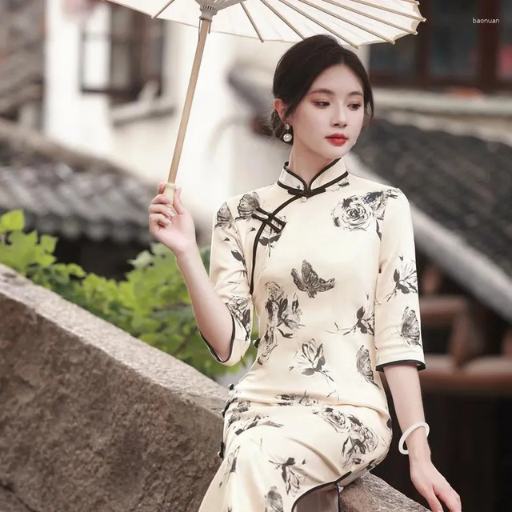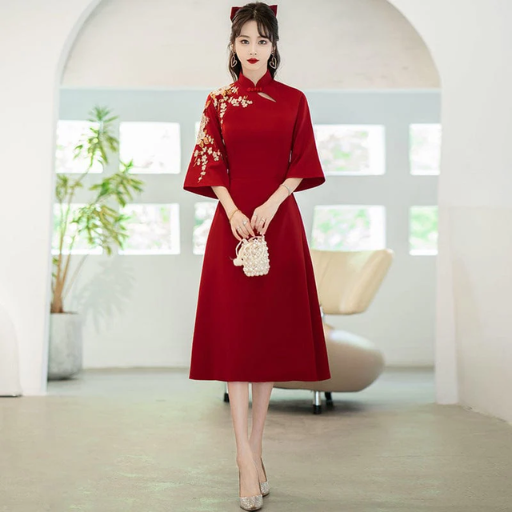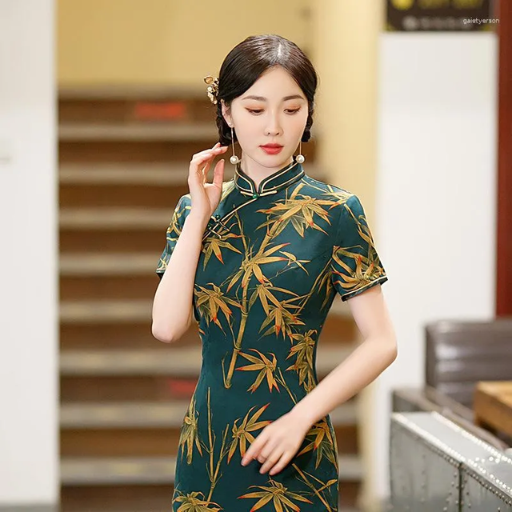Did you know? “Qipao” and “Cheongsam” are usually considered similar terms, yet their histories, cultural connotations, and subtle discrepancies do actually have much more than meets the eye. These unique items of clothing are a special part of Chinese culture but come from very distinct origins and perhaps have evolved in ways not fully known to many.
This comprehensive guide will help you understand the fascinating story behind these two elegant silhouettes and their modern interpretations. Whether you’re intensely curious about fashion history or a discerning fashionista, this exploration will clarify what makes these garments both unique and timeless.
Historical Context and Origins

Timeline of Development
- Qing Dynasty (1644-1912): Origin of the traditional Manchu “banner gown”
- 1920s-1930s: Major transformation during the Republican Era in Shanghai
- Modern Era: Contemporary adaptations and global recognition
The origin of the Qipao and Cheongsam is traceable to the 1920s in China, a time when social and cultural changes were affecting wide variations. In crafting a more modern look, the contemporary Qipao was derived from Manchu-style clothing of the Qing Dynasty, wherein they more or less stopped carrying the baggy image and adopted a more form-fitting design system, in line with modern tastes.
Origins of the Cheongsam
The cheongsam was initiated during the Qing Dynasty (1644–1912), which was an era of Manchu rule in China. It was derived from the traditional attire of the Manchu women with what was called a “banner gown,” featuring:
- Loose-fitting, straight-cut structure
- Conservative design emphasizing modesty
- High collars and long sleeves
- Bodies mostly covered
The modern cheongsam experienced a complete makeover during the Republican Era of Shanghai in the 1920s and 1930s. The silhouette became more form-fitting, thanks to Western tailoring influences, while still representing classical elegance.
Development of the Qipao
The qipao, having older roots, really acquired its popularity in the early 20th century. Based on Manchu costume traditions, the early qipao emphasized:
- Immobility and pure gracefulness
- Loose, ankle-length design
- High necklines and long sleeves
- Sartorial conservation
Cultural Significance and Symbolism

Role in Chinese Traditions
The qipao continues to play an important role in Chinese cultural celebrations:
- Wedding Ceremonies: Red qipao with elaborate embroidery symbolizing good luck, prosperity, and happiness
- Lunar New Year: Worn to commemorate traditions and express wishes for prosperity
- Cultural Festivals: Used to bridge old Chinese culture with modern expressions
- International Heritage Fairs: Promoted by the government and cultural organizations
Symbolism in Modern Society
In present-day culture, the qipao carries significant symbolic value:
- Identity Connection: 70% of Chinese people feel culturally connected via traditional symbols
- National Pride: Used during international events like the Olympics to represent Chinese culture
- Digital Presence: Social media platforms strengthen symbolic connections among youth
- Global Recognition: Represents Chinese heritage in international fashion circuits
Key Differences Between Qipao and Cheongsam

| Aspect | Qipao | Cheongsam |
|---|---|---|
| Language Origin | Mandarin Chinese | Cantonese |
| Primary Usage | Mainland China | Hong Kong, Overseas Chinese |
| Cultural Context | Traditional Chinese mainland culture | Cantonese and international contexts |
| Modern Interpretation | Emphasis on cultural heritage | More westernized adaptations |
Silhouette and Design Elements
The traditional silhouette embodies elegant features:
- High neck (mandarin collar)
- Short or long sleeves
- Straight, slim-cut form
- Side slits for comfort and mobility
- Form-fitting design to flatter the wearer
Fabric Choices and Styles
Traditional Materials
- Silk (a luxury and elegant drape)
- Satin (smooth texture)
- Brocade (rich patterns)
- Traditional embroidery
Modern Materials
- Cotton (25% increase in searches)
- Linen (sustainable option)
- Velvet and lace (evening wear)
- Spandex blends (flexibility)
Modern Interpretations and Global Fashion

Contemporary Fashion Trends
Modern cheongsams successfully combine timeless elegance with contemporary twists:
- Sustainable Materials: 67% of shoppers prioritize sustainability
- Digital Fashion: Virtual outfits and metaverse fashion shows
- Inclusivity Focus: Wider size ranges and diverse representation
- Technology Integration: Smart fabrics and wearable technology
Global Fashion Adaptations
International Recognition Milestones
- 2008 Beijing Olympics: Female staff wore qipao styles to represent Chinese civilization
- Hollywood Integration: Qipao-inspired designs in international fashion circuits
- Global Market Growth: $1 billion sustainable fashion industry expanding to $15 billion by 2030
- Cultural Fusion: Traditional textiles incorporated into contemporary designs
Hanfu vs Qipao and Cheongsam
| Characteristic | Hanfu | Qipao/Cheongsam |
|---|---|---|
| Historical Period | Han Dynasty (206 BCE–220 CE) | Qing Dynasty (1644–1912) |
| Design Style | Loose-flowing robes, broad sleeves | Form-fitting, high collar, side slits |
| Cultural Representation | Ancient ritualistic customs | Modern urban sophistication |
| Modern Popularity | 20% increase in sales (2023) | 5.2% annual growth rate |
Practical Styling and Fashion Tips

Choosing the Right Outfit for Occasions
Formal Events
- Silk qipao with intricate embroidery
- Jewel tones (emerald, sapphire, ruby)
- Pearl accessories
- Low-heeled pumps
Casual Occasions
- Cotton or linen materials
- Minimalist jewelry
- Comfortable flats
- Modern prints and colors
Accessorizing Your Qipao or Cheongsam
Recent search trends show growing interest in proper styling:
- Jewelry: 45% increase in searches for “minimalist jewelry for cheongsam”
- Hair Accessories: 50% increase in searches, trending toward ornate pins and floral headbands
- Footwear: “Comfortable shoes for cheongsam” ranks high in searches
- Bags: Growing interest in “vintage embroidered bags”
Maintaining Elegance and Authenticity
Modern styling approaches that respect cultural heritage:
- Preserve traditional elements (mandarin collars, frog closures, embroidery)
- Experiment with contemporary fabrics and sustainable materials
- Incorporate modern adjustments (adjustable slits, sleeveless options)
- Use authentic accessories (jade necklaces, pearl earrings)
Frequently Asked Questions
The terms qipao and cheongsam are almost synonymous, used to describe a traditional Chinese dress for women. However, qipao is the Mandarin term more commonly used in mainland China, while cheongsam derives from Cantonese and is more popular in Hong Kong and among overseas Chinese communities. Both refer to the same style of elegant, form-fitting dress with a high collar and side slits.
Both represent traditional Chinese attire with particular cultural significance. They are worn at weddings, festivals, and various formal occasions, symbolizing grace and femininity. They have also reflected Chinese fashion trends and changes in women’s social status throughout history, serving as bridges between traditional Chinese culture and modern expressions.
Modern styles vary greatly, containing both traditional designs and contemporary adaptations. Some looser versions are popular for comfort, while body-hugging styles remain classic. Designers often mix modern fabrics and prints to make the cheongsam suitable for various occasions, from casual wear to elegant evening attire.
Yes, qipao and cheongsam are still worn by Chinese women today, particularly during special occasions such as weddings or cultural festivities. These garments are celebrated as representations of Chinese culture and appear both in traditional contexts and modern fashion shows, offering contemporary twists on traditional styles.
The mandarin collar is essential to both qipao and cheongsam, giving them their distinctive appearance. Besides providing elegance and sophistication to these garments, the high collar represents traditional Chinese aesthetics. It serves as a visual representation of cultural identity and respect for Chinese heritage.
Conclusion
The story of qipao and cheongsam represents more than just fashion—it’s a narrative of cultural evolution, identity, and the beautiful fusion of tradition with modernity. While these terms may refer to the same elegant silhouette, their distinct linguistic origins and cultural contexts add depth to their significance.
As these garments continue to evolve in contemporary fashion, they maintain their role as powerful symbols of Chinese heritage while adapting to modern tastes and global influences. Whether you choose to call it qipao or cheongsam, this timeless dress remains a testament to the enduring beauty of Chinese craftsmanship and cultural expression.
Reference Sources
- First-Half-of-Twentieth-Century Modern Women Defined by the Qipao.
This research paper investigates the qipao and its cultural and historical role within the Metropolitan Museum. - An Exploration on the Cultural Appropriation of Traditional Chinese Fashion
The thesis treats the qipao (cheongsam) as a mode of liberation for women in China and traces the transformations in its use. - Traditional Chinese Art and Culture in Contemporary Chinese Fashion
The paper explores the intersection of traditional Chinese costume with contemporary fashion, including that of the qipao.







